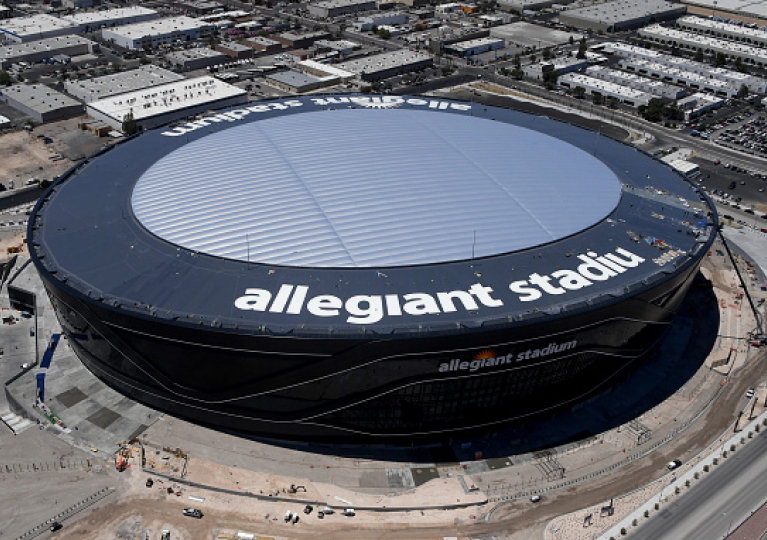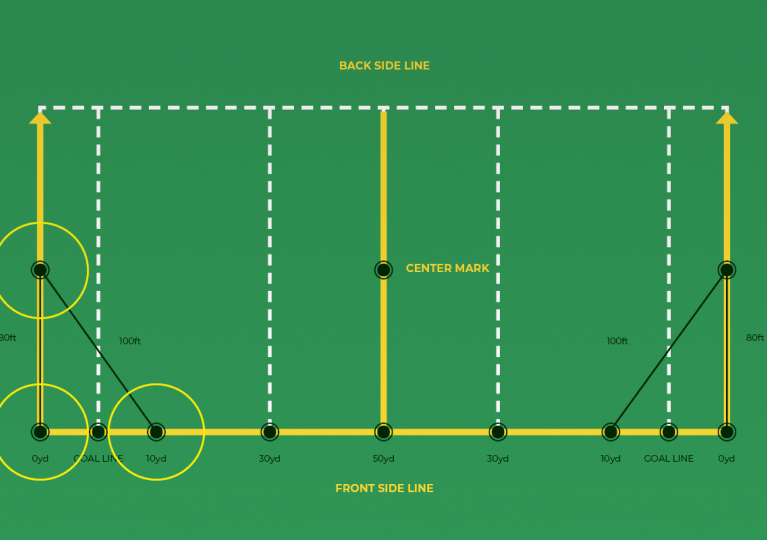You may ask any veteran football player, they will all agree unanimously that while playing they have a crystal clear image of every inch of the playing ground in their mind. Strength, explosiveness, agility, position-specific skills, are not the only requisites in the making of a successful football player. One needs to be mindful of the playing area where he has to flaunt his skills to bring his team to the match.
Today we will look to explore everything about the football field, starting from dimensions, markings on the field, sidelines, end lines, playing surface, and much more.
For an instance we can assume that details of the field are not of utmost importance from a viewer’s point of view, a viewer might argue that even with the basic knowledge of the field dimensions he can enjoy the game. But from the perspective of a budding player, it is of great interest and value. A player should know these details by heart, it should be so clear to him that he can even imagine a descriptive picture of a playing field in his mind. For more information on different types of content, you can visit our more BLOGS.
Football stadiums:
A stadium is an outermost structure that consists of both the playing arena and the seating arrangements for the loving fans. There is no such measurement for a football stadium both at the college level and the NFL level.
However, there are two major variations in the football stadiums that you will come across.

Domed stadiums: stadiums that have a rooftop covering that provides insulation from all kinds of weather are called domed stadiums. In domed stadiums, players and the audience are not subordinate to the mercy of the weather. Most domed stadiums have artificial turf to facilitate play.
Open stadiums: these are traditional stadiums where the playing arena is open and right beneath the sky.
Length of a football field:
A football field is 120 yards long, and this has remained consistent since 1981. In 1912 two end zones of 10 yards each on either side of the playing arena were introduced.
The field is having a marking at every 5 yards, and at every 10 yards, there is a number marking.
Width of a football field:
The width of a football field is set at 53 1/3 yards or 160 feet for both college and NFL levels.
This makes us arrive at the conclusion that all football games are played on a field that is 360 feet long and 160 feet wide.
Markings on the football field:
A newbie might wonder why there are so many markings and lines on the football field. It can be confusing upfront but don’t worry we’ll decode them one by one.
End lines: these are the outermost line of the football field.
Goal lines: goal lines are drawn 10 yards inside the end lines, the concept of goal lines was introduced in 1912 and afterward the playing field is restricted to 100 yards.
Field of play: the remaining are on which the game of football is played and which is enclosed by the two sidelines and the two-goal lines.
50-yard line: as the name suggests this line divides the playing field into two halves. With each team defending his half and trying to score goals on the opponent’s half.
Yard lines: yard lines are drawn parallel to the goal line at every 5 yards across the football field. Yard lines facilitate viewers and players to estimate how much further a team needs to carry the ball before scoring the first down.
While moving away from the goal post on either side, the number ascends from 1 to 50.
Hash marks: hash marks have different rules in the case of high school
l, college, and NFL level.
At NFL level it is marked exactly 70 feet, and 9 inches from the sidelines
Whereas at high school and college football fields, the hash marks are marked 60 feet from the sidelines.
Other key markings:
- At the center of the 2-yard line, a 3-foot line is marked, this line runs parallel to the goal line. This line is indicative of the two-point conversion attempt.
- Most professional games and some college-level games have team logos painted at the 50-yard line, these are nothing but promotional logos and are not mandatory. You will witness logos in tandem in the Super Bowl Games.
Player benches and standing arena: substitutes, coaching staff and other team management are allowed to stand behind a white line drawn 6 feet from the sidelines. 6 feet behind this white line is where the dugout of teams is built.
Playing surface:
Natural grass: it is traditional, and the most commonly used approach. This grass is naturally grown on the field and is much softer than the artificial counterpart. However, natural grass comes with one major disadvantage that it requires extensive care and maintenance.
Artificial turf: synthetic grass-like appearing fibers are made out of nylon and other synthetic materials that resemble natural grass and facilitate the play of football. Once laid artificial turf needs very less maintenance, and this is possibly why it is getting popular.
This is how artificial Turf looks like:
Goal Post:
The ultimate aim of the game is to score goals and bag as many points as one can. The crossbar in football is 10 feet high, while the posts are 20 feet in height. This sums for a total height of 30 feet.
The height of the crossbar is the same at both the NFL and high school level but the width of the goal post isn’t.
At NFL level goal posts are 18 feet and 6 inches wide, while at High school level they are 23 feet and 4 inches wide.
At all levels, the goal post is slingshot shaped, and also there is a post that is gooseneck-shaped which is anchored to the ground.
Ribbon attached to the top of the goal post in the NFL: only in the NFL do we find a ribbon being attached to each goal post. This ribbon is indicative of the wind direction and wind speed. Having insights about the wind direction and speed enables players to take an accurate shot at the goal.
People also ask:
We have just covered the basics of the football field and we are well aware of the fact that queries are bound to root up.
- Why is a football field called a Gridiron?
A Gridiron is a metal plate with parallel bars being soldered to it, it is used for grilling meat and veggies on fire. As we know there are additional lines on the football field spanning from one end line to the other, these markings give the football field a structure very closely resembling that of a Gridiron.
This is why the football field and sometimes even the sport itself is referred to as Gridiron.
- Which one is the best NFL stadium?
Well, there can be differing opinions on this but as per the popular opinion, Lambeau Field which is the home ground of Green Bay Packers is regarded as the best stadium. It has an on-paper capacity of 81,441 and has hosted football matches since 1957.
- Is the NFL field bigger than the college football field?
I don’t know if you have noticed or not, but we have already answered this question while discussing the field dimensions.
No, the NFL field is not bigger than the college level field; the dimensions of the football field at any level are fixed at 120 yards long and 53 1/3 yards wide.
However, there is a slight difference in the Hash markings at the NFL and college levels. In the NFL the space between two hash marks is 53 feet, 4 inches while in college-level it is 18 feet and 6 inches.

